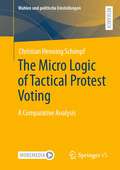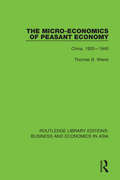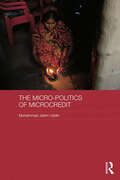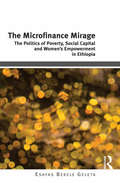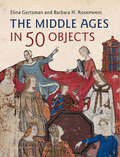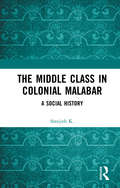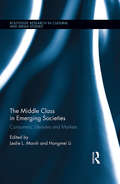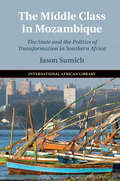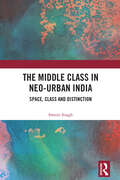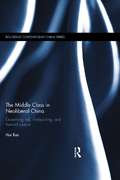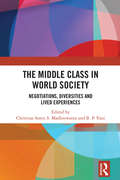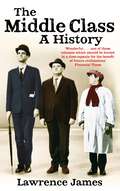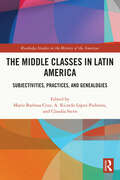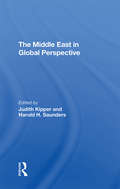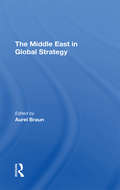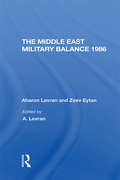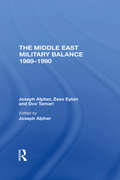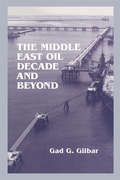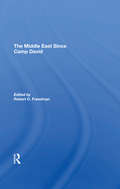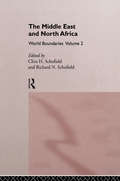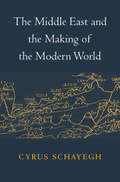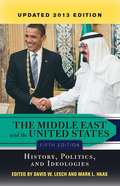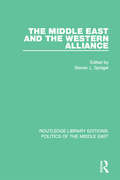- Table View
- List View
The Micro Logic of Tactical Protest Voting: A Comparative Analysis (Wahlen und politische Einstellungen)
by Christian Henning SchimpfThis book identifies the different forms that protest voting can take in times when populism flourishes. Contrary to the popular view of protest voting as merely venting frustration, this book argues that protest voting can also be conceived of as a strategic signal of discontent, originating from sources, such as party policy positions. The empirical analyses rest on election survey data collected in democratic countries around the world between 2005 and 2017 to understand protest voting as a strategic signal, and the conditions under which it occurs. The main results show that protest voting can indeed be a strategic signal. This finding challenges the predominant view in the literature and the public discourse of protest voters as aimless, frustrated voters.
The Micro-Economics of Peasant Economy, China 1920-1940 (Routledge Library Editions: Business and Economics in Asia #25)
by Thomas B. WiensThe objectives of this study, first published in 1982, are to elaborate a micro-economic model which adequately explains the interrelationships among economic forces determining the distribution of income in a peasant economy in the early stages of transition to industrialization. It also examines the development of the ‘dual economy’, an economy composed of a large peasant agricultural sector with its ancillary handicraft sector, both traditional in techniques and institutions, and a small but growing modern industrial sector.
The Micro-politics of Microcredit: Gender and Neoliberal Development in Bangladesh (ASAA Women in Asia Series)
by Mohammad Jasim UddinMicrocredit has been seen in recent decades as having great potential for aiding development in poor developing countries, with Bangladesh being one of the countries which has pioneered microcredit and implemented it most widely. This book, based on extensive original research, explores how microcredit works in practice, and assesses its effectiveness. It discusses how microcredit, usually channelled through women, is often passed to the men of the family, a practice disapproved of by some, but regarded as acceptable by borrowers who have a communal approach to debt, rather than viewing debt as something held by single individuals. The book demonstrates how the rules around microcredit are often seem as irksome by the borrowers, how lenders often charge high rates of interest and work primarily to preserve their institutions, thereby going against the spirit of the microcredit movement, and how borrowers often end up on a downward spiral, deeper and deeper in debt. Overall, the book argues that although microcredit does much good, it also has many drawbacks.
The Microfinance Mirage: The Politics of Poverty, Social Capital and Women's Empowerment in Ethiopia
by Esayas Bekele GeletaMicrofinance has long been considered a development strategy that can correct the failure of the global credit market and address the financial needs of the poor enabling them to create and run profitable business enterprises. The Microfinance Mirage argues that this neo-liberal oriented analysis overemphasises the economic argument whilst ignoring the cultural roots of inequality and subordination. Drawing on ethnographic research conducted among rural credit clients in the Northern region of Ethiopia, Esayas Bekele Geleta provides a nuanced critical analysis of microfinance challenging the common assumption that it facilitates the building of social capital, poverty reduction and the empowerment of women. Making a unique contribution to our further understanding of the microfinance industry the research shows that, in some cases, microfinance can result in the disintegration of pre-existing relationships and in the disruption and destruction of the livelihoods of the poor. Exploring the impact of microfinance in one of the poorest regions of sub-Saharan Africa, this book demonstrates its potential and problems and shows the complex and contradictory social and cultural environments in which projects are often located.
The Middle Ages in 50 Objects
by Barbara H. Rosenwein Elina GertsmanThe extraordinary array of images included in this volume reveals the full and rich history of the Middle Ages. Exploring material objects from the European, Byzantine, and Islamic worlds, the book casts a new light on the cultures that formed them, each culture illuminated by its treasures. The objects are divided among four topics: The Holy and the Faithful; The Sinful and the Spectral; Daily Life and Its Fictions; and Death and Its Aftermath. Each section is organized chronologically, and every object is accompanied by a penetrating essay that focuses on its visual and cultural significance within the wider context in which the object was made and used. Spot maps add yet another way to visualize and consider the significance of the objects and the history that they reveal. Lavishly illustrated, this is an appealing and original guide to the cultural history of the Middle Ages.
The Middle Class in Colonial Malabar: A Social History
by Sreejith K.Members of the middle class in colonial Malabar left behind a copious amount of writings. These are to be found, among other places, in magazines, autobiographies and diaries. This book explores the social history of the middle class in the region during the British period on the basis of these writings in combination with archival sources. It delves into how they conceptualized domesticity, forged new friendships cutting across caste, and sometimes, even racial lines, and the new forms of leisure they envisaged. The author also analyses the dilemmas the group faced as it responded to the changes unleashed by colonial modernity at their work places, in the public sphere, and inside homes, where they desperately clung on to tradition even while accepting much of what the West had to offer. Please note: Taylor & Francis does not sell or distribute the Hardback in India, Pakistan, Nepal, Bhutan, Bangladesh and Sri Lanka.
The Middle Class in Emerging Societies: Consumers, Lifestyles and Markets (Routledge Research in Cultural and Media Studies)
by Leslie L. Marsh Hongmei LiThis volume examines the discursive construction of the meanings and lifestyle practices of the middle class in the rapidly transforming economies of Asia, Latin America, Africa and the Middle East, focusing on the social, political and cultural implications at local and global levels. While drawing a comparative analysis of what it means to be middle class in these different locations, the essays offer a connective understanding of the middle class phenomenon in emerging market economies and lay the groundwork for future research on emerging, transitional societies. The book addresses three key dimensions: the discursive creation of the middle class, the construction of the cultural identity through consumption practices and lifestyle choices, and the social, political and cultural consequences related to globalization and neoliberalism.
The Middle Class in Mozambique: The State and the Politics of Transformation in Southern Africa (The International African Library #57)
by Jason SumichIn recent years, the growth of a middle class has been a key feature of the 'Africa Rising' narrative. Here, Sumich explores the formation of this middle class in Mozambique, answering questions about the basis of the class system and the social order that gives rise to it. Drawing extensively on his fieldwork, Sumich argues that power and status in dominant party states like Mozambique derives more from the ability to access resources, rather than from direct control of the means of production. By considering the role of the state, he shows how the Mozambican middle class can both be bound to a system they benefit from and alienated from it at the same time, as well as exploring the ways in which the middle classes attempt to reproduce their positions of privilege and highlighting the deep uncertain future that they face.
The Middle Class in Neo-Urban India: Space, Class and Distinction
by Smriti SinghThis book critically examines the new middle class and the emergence of neo-urban spaces in India within the context of rapid urbanisation and changing socio-spatial dynamics in urban areas in the country. It looks at class as a socio-spatial category where class distinction is tied to and manifests itself through the space of the city. With a detailed ethnographic study of the national capital region of Delhi, especially Gurugram, it explores themes such as class subjectivity, morality and social beliefs; life inside gated enclaves; family and everyday practices of class reproduction; and the process of othering and exclusivity, among others. Class identity, vulnerability and hierarchy influence the actions and motivations of the middle class. The author studies the nuances and socio-political fractures stemming from the complex dynamic of class, caste, religion and gender that manifest in these neo-urban spaces and how these shape the city and community. Rich in empirical resources, this book will be of interest to scholars and researchers of sociology, political sociology, ethnography, urban sociology, urban studies and South Asian studies.
The Middle Class in Neoliberal China: Governing Risk, Life-Building, and Themed Spaces (Routledge Contemporary China Series)
by Hai RenSince the late 1970s, China’s move towards neoliberalism has made it not only one of the world’s fastest growing economies, but also one of the most polarised states. This economic, social and political transformation has led to the emergence of a new Chinese middle class, and understanding the development and the role of this new social group is crucial to understanding contemporary Chinese society. Investigating the new politics of the middle class in China, this book addresses three major questions. First, how does the Chinese state deal with problems of national sovereignty and political representation to create the middle class both as a legitimate category of the people and as an ideal norm of citizenship? Second, how does the recognition of the middle class norm take place in the practice of everyday life? Finally, what kind of risks does the politics of the middle class generate not only for middle class subjects but also for the disenfranchised? In answering these questions, this book examines a set of practices, bodies of knowledge, measures, and institutions that aim to manage, govern, control, and orient the behaviours, gestures, and thoughts of Chinese citizens. This investigation contributes not only to the understanding of the Chinese middle class society but also to the scholarly debate over the relationship between governmental apparatuses, subjectification, and life-building. Drawing on ethnographic information, historical archives, and the media, this book will be of great interest to students and scholars working in the fields of Chinese studies, Chinese politics, ethnic studies and urban studies, as well as those interested in culture, society, class and welfare.
The Middle Class in World Society: Negotiations, Diversities and Lived Experiences
by Christian Suter B. P. Vani S. MadheswaranThis volume delves into the study of the world’s emerging middle class. With essays on Europe, the United States, Africa, Latin America, and Asia, the book studies recent trends and developments in middle class evolution at the global, regional, national, and local levels. It reconsiders the conceptualization of the middle class, with a focus on the diversity of middle class formation in different regions and zones of world society. It also explores middle class lifestyles and everyday experiences, including experiences of social mobility, feelings of insecurity and anxiety, and even middle class engagement with social activism. Drawing on extensive fieldwork and in-depth interviews, the book provides a sophisticated analysis of this new and rapidly expanding socioeconomic group and puts forth some provocative ideas for intellectual and policy debates. It will be of importance to students and researchers of sociology, economics, development studies, political studies, Latin American studies, and Asian Studies.
The Middle Class: A History
by Lawrence JamesThis is the enthralling story of the great powerhouse of British history - the middle class. The death of feudalism, the advancement of democracy, the spread of literacy, the industrial and sexual revolutions, the development of mass media - the middle class is never far away, drawing up petitions, pushing for change in attitude and legislation, engaging in philanthropy. In this scholarly and hugely entertaining account, Lawrence James brings to life the stories of churchmen and charity-workers, lawyers and lobbyists to create an engaging and colourful social and political panorama. Richly textured and highly relevant, this is narrative history at its best.
The Middle Class: A History
by Lawrence James'A wonderfully enjoyable history of the changing fortunes of the middle orders over the past 500 years. A magisterial survey of the entire British class system, filled with richly detailed observation of the social differences on which it has thrived' Sunday Times'Comprehensive, engaging, sharp-eyed and fair-minded. A treasure trove for anyone who wants to know how we get from yokels to 'Marks and Sparks plonk' Daily Telegraph'An enchanting compendium of the games the English play, and the anxieties, frictions and resentments engendered in the pursuit of status' Times Literary Supplement This is the enthralling story of the great powerhouse of British history - the middle class. The death of feudalism, the advancement of democracy, the spread of literacy, the industrial and sexual revolutions, the development of mass media - the middle class is never far away, drawing up petitions, pushing for change in attitude and legislation, engaging in philanthropy. In this scholarly and hugely entertaining account, Lawrence James brings to life the stories of churchmen and charity-workers, lawyers and lobbyists to create an engaging and colourful social and political panorama. Richly textured and highly relevant, this is narrative history at its best.
The Middle Classes in Latin America: Subjectivities, Practices, and Genealogies
by Claudia Stern Mario Barbosa Cruz A. Ricardo López-PedrerosAs a collective effort, this volume locates the formation of the middle classes at the core of the histories of Latin America in the last two centuries. Featuring scholars from different places across the Americas, it is an interdisciplinary contribution to the world histories of the middle classes, histories of Latin America, and intersectional studies. It also engages a larger audience about the importance of the middle classes to understand modernity, democracy, neoliberalism, and decoloniality. By including research produced from a variety of Latin American, North American, and other audiences, the volume incorporates trends in social history, cultural studies and discursive theory. It situates analytical categories of race and gender at the core of class formation. This volume seeks to initiate a critical and global conversation concerning the ways in which the analysis of the middle classes provides crucial re-readings of how Latin America, as a region, has historically been understood.
The Middle East In Global Perspective
by Judith Kipper Harold SaundersWell before events in the Soviet Union and Eastern Europe dramatized the rapidity with which a new political world is evolving and before the Gulf War sharpened the focus on the Middle East agenda, scholars and policymakers alike were searching for different concepts for addressing the intractable problems facing the Middle East. Even though the re
The Middle East In Global Strategy
by Aurel Braun Avner Yaniv Edwin H Fedder Gerald SteinbergThis book emphasizes the vital links between international politics and strategy and provides a comprehensive analysis of strategic interests of the major international actors in the Middle East. It contends that the policies of the superpowers toward the Middle East are fragmented and unproductive.
The Middle East Maze: Israel and Her Neighbors
by David A. RauschThe Ottoman Empire; The Jewish State; Developments; Israel Middle East; Egypt and Jordan; Syria and Lebanon; Iraq and Iran; Libya PLO; The Arabian Peninsula; Israel
The Middle East Military Balance 1986
by Aharon Levran Joseph Alpher Zeev Eytan Daphne RazThis annual reference provides a statistical study of military trends in the Middle East and a collection of essays analyzing the details and strategic significance of events in the region. This fourth annual volume of the Middle East Military Balance covers the calendar year 1986. Strategic developments in the Middle East, a region of high geostrategic stakes and deep-rooted conflicts, redound vigorously on both regional and global peace and stability.
The Middle East Military Balance 1989-1990
by Joseph Alpher Zeev Eytan Dov TamariNow in its seventh year, this annual review provides a detailed database on military forces and strategic developments in the Middle East. It offers statistics on populations, resources and military infrastructures, on armed forces and the military capacity of each state in the region, and on the Palestinian Liberation Organization. This year's volume contains essays on the activities of major armies in the Middle East, as well as in-depth analyses of fundamental strategic trends of particular relevance during the 1990s.
The Middle East Oil Decade and Beyond
by Gad G. GilbarThis study of fundamental aspects of the oil decade examines the influence of oil production, export and revenues on domestic, regional and international relations. It highlights the expansion of higher education in the Arab world, and the increase in demand for industrial and consumer goods.
The Middle East Since Camp David
by Robert O FreedmanSince the Camp David agreements of September 1978, the Middle East has experienced a series of major military and political developments that have affected not just the nations of the region and the two superpowers, but the rest of the world as well. The fall of the Shah of Iran, the Soviet invasion of Afghanistan, the Iraqi invasion of Iran, the assassination of Egyptian President Anwar Sadat, and the Israeli invasion of Lebanon—to name only a few events—have had a major impact. In this volume, a group of internationally recognized scholars, many of whom are present and former U.S. government officials, analyze these Middle Eastern developments from the perspectives of the superpowers, the region in general, and the five major actors during this period (Egypt, Israel, the PLO, Syria, and Iran). Although the individual authors speak from differing perspectives and viewpoints in their analyses, the book as a whole presents a balanced examination of the key developments in the volatile Middle East since Camp David.
The Middle East and North Africa: World Boundaries Volume 2 (World Boundaries Series #Vol. 2)
by Clive H. Schofield Richard N. SchofieldMiddle East and North Africa brings together some of today's most influential analysts of a region which from colonial times to the present has seen great territorial change.
The Middle East and the Making of the Modern World
by Cyrus SchayeghCyrus Schayegh’s socio-spatial history traces how a Eurocentric world economy and European imperialism molded the Middle East from the mid-nineteenth to mid-twentieth century. Building on this case, he shows that the making of the modern world is best seen as the reciprocal transformation of cities, regions, states, and global networks.
The Middle East and the United States
by David W. Lesch Mark L. HaasThis acclaimed book brings together scholars and diplomats from the Middle East, Europe, and North America to provide an objective, cross-cultural assessment of U.S. foreign policy in the Middle East. This fifth edition has been substantially revised with greater emphasis on current events, including the policies of the Obama administration, Islamist perceptions of U.S. involvement in the Middle East, and the U.S. relationship with Israel, Saudi Arabia, Turkey, and Afghanistan.Updated throughout, this edition also features five new chapters on the superpowers and the Middle East throughout the Cold War; the Bush and Obama administrations and the Arab-Israeli conflict; contemporary U.S.-Syrian relations; the importance of ideology to U.S.-Iranian relations under the last three administrations; and U.S. relations with Al Qaeda.
The Middle East and the Western Alliance (Routledge Library Editions: Politics of the Middle East #13)
by Steven L. SpiegelThis volume, first published in 1982, provides a comprehensive analysis of the problems affecting the interests of the Western Alliance (the North Americans, the Europeans and the Japanese), the Middle East states, and the Soviet Union. The authors, all internationally recognized experts in their fields, bring together different and distinctive perspectives on such central issues as the Arab-Israeli dispute, the dynamics of the energy crisis, alliance unity and the role of the Soviet Union, and the effect of growing Middle East instability on the interests of individual allied countries. The chapters address the major issues both historically and in terms of current events; and they seek to examine relationships both from the perspective of the various countries and of the Alliance as a whole.
